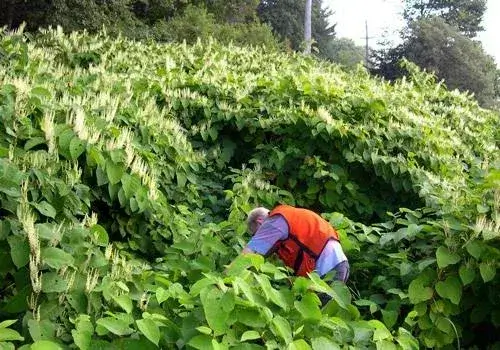
Japanese knotweed (Polygonum cuspidatum Sieb. & Zucc.), a member of the buckwheat family, was introduced into the U.S. from Eastern Asia (Japan, China, Korea) as an ornamental on estates in the late-1800s. It has also been used as an erosion control plant. By the mid-1890s, it was reported near Philadelphia, PA, Schenectady, NY, and in New Jersey. Although once sold through seed and plant catalogs, by the late-1930s knotweed was already being viewed as a problematic pest. The plant, which can grow from three to 15 feet tall, has bamboo-like stems and is sometimes called Japanese bamboo. As with many invasive plants, knotweed thrives in disturbed areas and once established can spread rapidly, creating monoculture stands that threaten native plant communities. Japanese knotweed can tolerate deep shade, high temperatures, high soil salinity and drought. It is commonly found along streams and rivers, in low-lying areas, disturbed areas such as rights-of-way, and around old home and farmsteads.

The plant is an upright, shrubby, herbaceous, woody-appearing perennial reaching heights of 10 to 15 feet (3 to 4.5 m). The stems are smooth, stout, and hollow. Where the leaves attach to the stem, the stem is swollen with a membranous sheath surrounding the joints. The leaves are broadly ovate (broad and rounded at the base and tapering toward the end), 3 to 6 inches (8 to 15 cm) long by 2 to 4 inches (5 to 10 cm) wide, alternating on stem, broadly oval to somewhat triangular or heart-shaped, pointed at the tip. The plant’s shoots come up from a network of spreading rhizomes. These horizontal roots can reach lengths of 65 feet (20 m) or more. Japanese knotweed has branched sprays of small greenish-white flowers from August to September. Although they have complementary male and female organs, those organs are vestigial and the flowers function unisexually. The plant develops small winged fruits Seeds: triangular, shiny, very small, about 1/10 inch (2.5 mm) long. Japanese knotweed spreads primarily by seed (transported by wind, water, animals, humans, or as a soil contaminant), stem fragments, and by shoots sprouting from its system of rhizomes.

Japanese knotweed spreads rapidly, forming dense thickets that crowd and shade out native vegetation. This reduces species diversity, alters natural ecosystems, and negatively impacts wildlife habitat. The ground under knotweed thickets tends to have very little other growth. This bare soil is very susceptible to erosion, posing a particular threat to riparian areas. Once established, populations of Japanese knotweed are extremely persistent and hard to eradicate.

As with most invasive plants, Japanese knotweed can quickly inhabit disturbed ecosystems. One of the best ways to prevent its colonization is to ensure that disturbed habitats are rehabilitated with native vegetation before knotweed can invade.
Mechanical control
Single young plants can be pulled by hand depending on soil conditions and root development. If all of the root system isn’t removed, re-sprouting can occur. For small initial populations beyond single plants, or in environmentally sensitive areas where herbicides cannot be used, grubbing with a pulaski or similar tool to remove all of the roots after cutting back the standing vegetation can be an effective control measure. All parts of the removed plants should be bagged and disposed of in a secure location. It is best if knotweed not be mown or cut with weed trimmers as the pieces of the plant can easily get moved around and re-sprout, spreading, rather than controlling the plant.
Chemical control
Chemical controls for Japanese knotweed include application of glyphosate and triclopyr herbicides to freshly cut stems or to foliage. Before using chemicals to control any invasive plant, check with your local environmental or natural resources management agency or Cooperative Extension office to find out what chemicals are legal for use on knotweed in your area.
This map shows confirmed observations (green points) submitted to the NYS Invasive Species Database. Absence of data does not necessarily mean absence of the species at that site, but that it has not been reported there. For more information, please visit iMapInvasives.
Andersen, R.N. 1968. Germination and Establishment of Weeds for Experimental Purposes. Weed Science Society of America Handbook. WSSA, Illinois.
Bailey, L.H. 1949. Manual of Cultivated Plants. Macmillan, New York.
Fernald, M.L. 1950. Gray's Manual of Botany 8th ed. American Book Co., Boston.
Gleason, H.A. 1952. The New Britton and Brown Illustrated Flora of the Northeastern United States and Adjacent Canada. Macmillan Publishing Co., Inc. New York.
Gleason, H.A. and A.C. Cronquist. 1991. Manual of Vascular Plants of the Northeastern United States and Adjacent Canada. 2nd ed. New York Botanical Garden, Bronx, New York.
Holmgren, N.H. 1998. Illustrated Companion to Gleason and Cronquist's Manual. New York Botanical Garden, Bronx, New York.
Magee, D.W and H.E. Ahles. 1999. Flora of the Northeast. University of Massachusetts Press, Amherst, MA.
Moul, E.T. 1948. A dangerous weedy Polygonum in Pennsylvania. Rhodora 50:64-66.
Newcomb N. 1977. Newcomb's Wildflower Guide. Little Brown, Boston.
Seiger, L.A. 1996. Fallopia japonica. p.77. In Randall, J.M. and J. Marinelli. [eds.]. Invasive Plants: Weeds of the Global Garden. Brooklyn Botanic Garden Inc., New York.
Sultan, S.E. 2001. Phenotypic plasticity for fitness components in Polygonum species of contrasting ecological breadth. Ecology 82 (2): 328-343.
Sultan, S.E., A.M. Wilczek, S.D. Hann, B.J. Brosi. 1998. Contrasting ecological breadth of co-occurring annual Polygonum species. Journal of Ecology 86 (3): 363-383.
USDA, NRCS. 2001. The PLANTS Database, Version 3.1. (http://plants.usda.gov). National Plant Data Center, Baton Rouge, LA 70874-4490 USA.
Zika, P.F. and A.L. Jacobson. 2003. An overlooked hybrid Japanese knotweed (Polygonum cuspidatum x sachalinense; Polygonaceae) in North America. Rhodora 105(922): 143-152.
